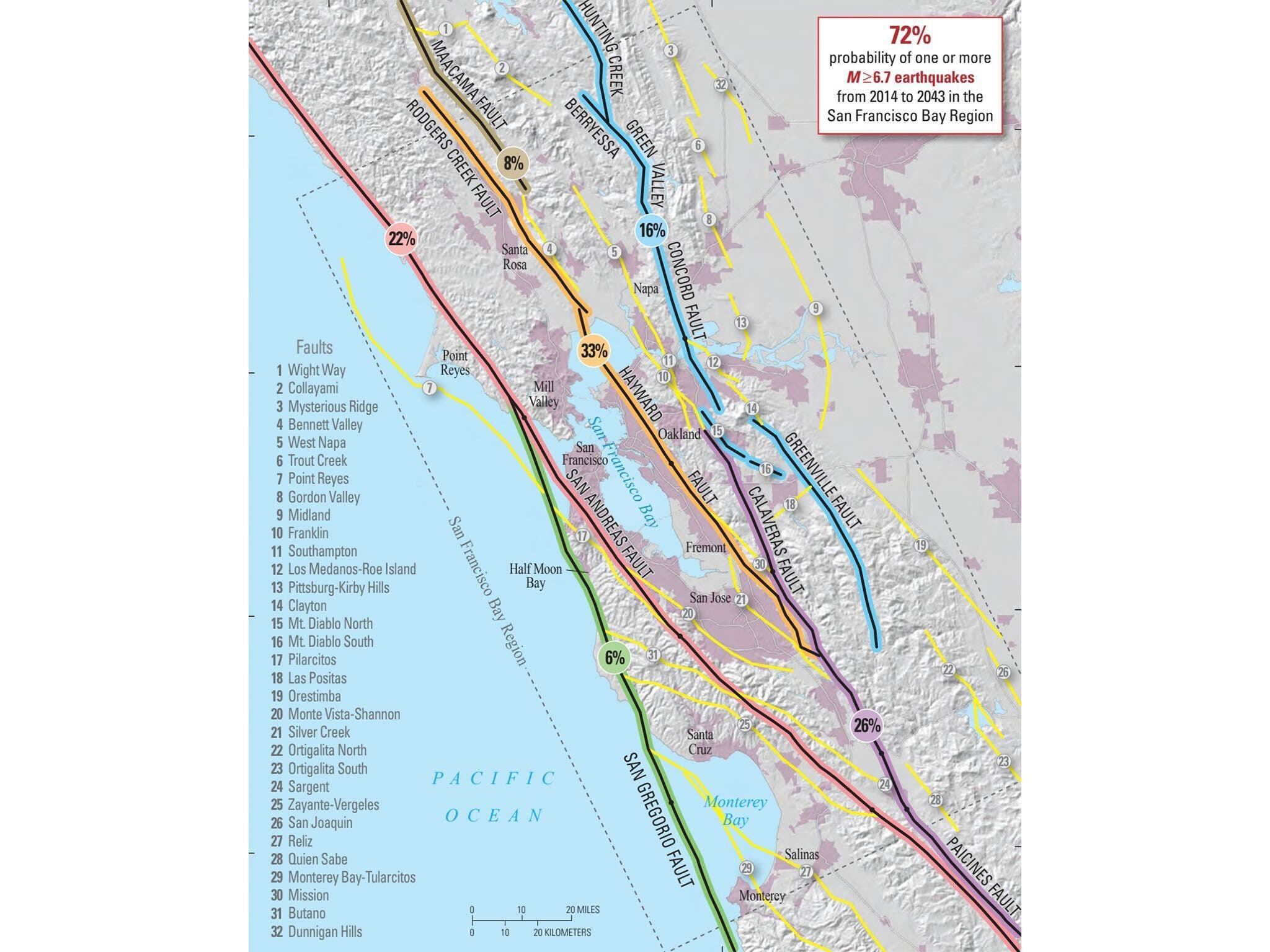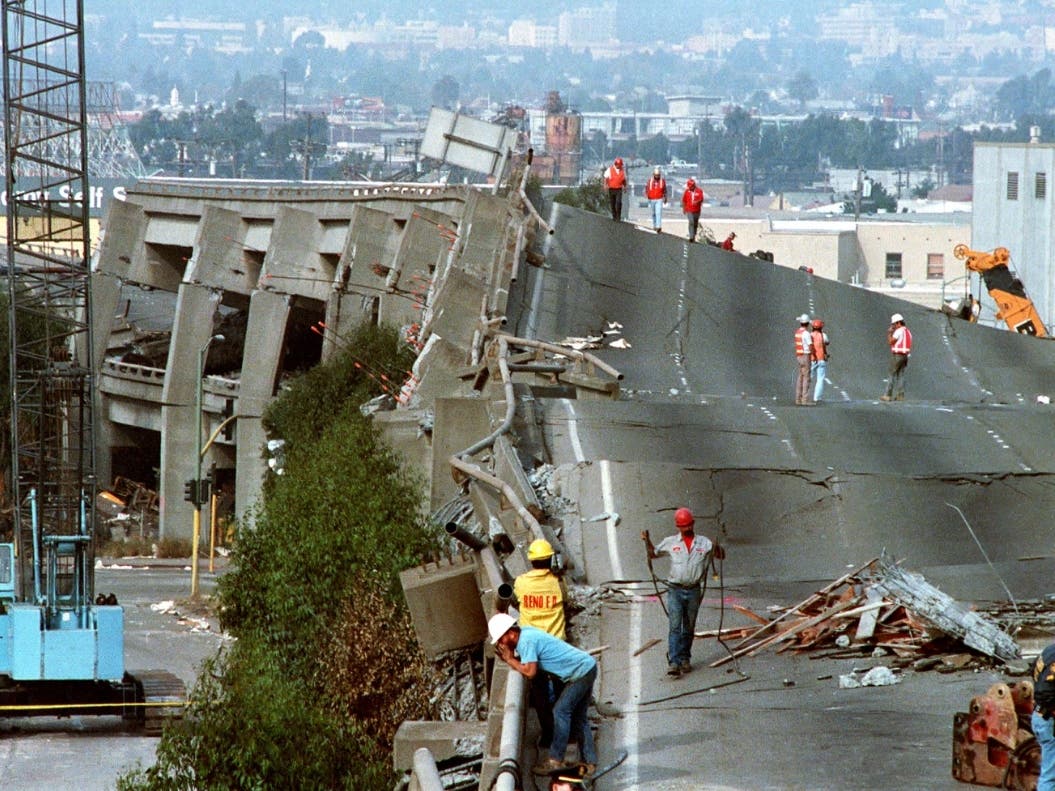MOUNTAIN VIEW, CA — A major earthquake striking the San Francisco Bay Area within the next 30 years is not just possible — it’s likely, a United States Geological Survey expert told Patch.
There’s a 72 percent chance of a magnitude 6.7 or larger earthquake striking the region in that timeframe, said Sarah Minson, a research geophysicist with the USGS Earthquake Science Center, located at NASA Ames in Mountain View. There’s also a 51 percent chance for magnitude seven or larger, a 20 percent chance for seven and a half or larger, and a 4 percent chance for a magnitude eight.
These probabilities come from the USGS’s Uniform California Earthquake Rupture Forecast, version three.
“It’s a model that the USGS makes looking at long-term earthquake rates… and faults that we don’t know about in California,” Minson said in a phone interview with Patch on Tuesday.
“The Big One” has loomed large in the collective imaginations of Californians — a colloquial term for the inevitable, catastrophic earthquake expected to rupture along a major fault line like the San Andreas.
 Map depicting Earthquake Probabilities in the SF Bay Area by Fault. (USGS)
Map depicting Earthquake Probabilities in the SF Bay Area by Fault. (USGS)
More recently, reports like this one — detailing a decade-long retrofit of the Golden Gate Bridge to prepare for that “Big One” — have continued to stoke public anxiety.
But Minson warns that focusing on the abstract and less likely “major” earthquakes may be misguided.
“I think we have a tendency to focus on, the disaster, ‘The Big One,’ the magnitude eight, that does a lot of damage in a lot of places,” Minson said. “But in fact, most of the hazards come from [events] like that magnitude six earthquake in 2014 near South Napa.”
She pointed to that quake as an example of a so-called moderate earthquake with severe consequences.
Early on the morning of Aug. 24, 2014, residents of Napa were violently jolted awake by the temblor, which damaged many historic masonry buildings in downtown Napa. The quake shook houses off their foundations, damaged chimneys, ignited fires and broke water mains all over the city. It resulted in hundreds of millions of dollars in economic losses, according to the USGS.
It was the largest to shake the Bay Area since the 1989 6.9-magnitude Loma Prieta earthquake — a stark reminder of the region’s seismic vulnerability.
 A USGS map showing the widespread shaking of the 1989 Loma Prieta Earthquake. (USGS)
A USGS map showing the widespread shaking of the 1989 Loma Prieta Earthquake. (USGS)  A USGS map showing the areas shaken by the 2014 South Napa quake. (USGS)
A USGS map showing the areas shaken by the 2014 South Napa quake. (USGS)
“In fact, a lot of your hazard comes not from the largest magnitude earthquakes, but from more moderate magnitude earthquakes, which happen much more often,” she said. “Your rule of thumb is that each decrease in magnitude unit increases the frequency of the earthquakes by a factor of 10.”
Over the past century, the Bay Area has seen only a few large quakes — namely the 1906 7.9-magnitude San Francisco earthquake, which killed more than 3,000 people and remains one of the deadliest in U.S. history.
Entire State At Risk
When it comes to earthquake risk, both Northern and Southern California face sobering probabilities.
According to USGS projections, the San Francisco Bay Area has a 72 percent chance of experiencing a magnitude 6.7 or larger earthquake in the next 30 years. In Los Angeles, that probability is slightly lower, at 60 percent. But for even larger events — magnitude 7.5 or greater — the roles reverse: there’s a 31 percent chance in Los Angeles compared to 20 percent in the Bay Area. These figures are based on long-term seismic modeling and fault rupture histories.
The differences in probability stem largely from the timing of past ruptures and the behavior of major fault systems.
“We’ve had the 1906 earthquake in the Bay Area,” Minson explained. “The last time the southern San Andreas fault near Los Angeles ruptured was, I think, 1857 — so it’s a little bit farther away.”
In both regions, the level of risk depends not only on fault location but also on how long it has been since a major rupture — one of several factors used to calculate earthquake probabilities, according to the USGS.
But a lack of recent major quakes doesn’t mean the region is “overdue.”
“It’s very hard to say that any place is overdue, because again, earthquakes don’t happen predictably in time,” Minson said. “We can say that given long-term probabilities, there is a high probability of an earthquake happening in the Bay Area in the next 30 years.”
Preparedness Is Key
Still, Californians can — and should — prepare.
“You can prepare for earthquakes, and they’re very survivable,” Minson said. “California is well built for earthquake safety… Your building is not supposed to be a threat to your life in an earthquake,” she said, but added that hazards remain inside.
“You can have bookcases, things that can fall on your head. Right now I’m looking up at the ceiling tiles in my office,” she said. “So what we say is, if you feel shaking, please drop, cover, and hold on to protect yourself from anything that might fall on you.”
Most injuries, she added, come from people trying to move during quakes — tripping, falling, or running outside where facades or air conditioning units may fall.
Preparedness is key.
“It’s going to be just as tragic if [a family heirloom] gets knocked over in a magnitude five as if it gets knocked over in a magnitude eight,” she said.
“And the ways that you prepare for earthquakes are really handy for all sorts of disasters… Being prepared for one really helps you be prepared for all of them.”
Get more local news delivered straight to your inbox. Sign up for free Patch newsletters and alerts.
Posted Wed, Jul 23, 2025 at 9:16 am PT
